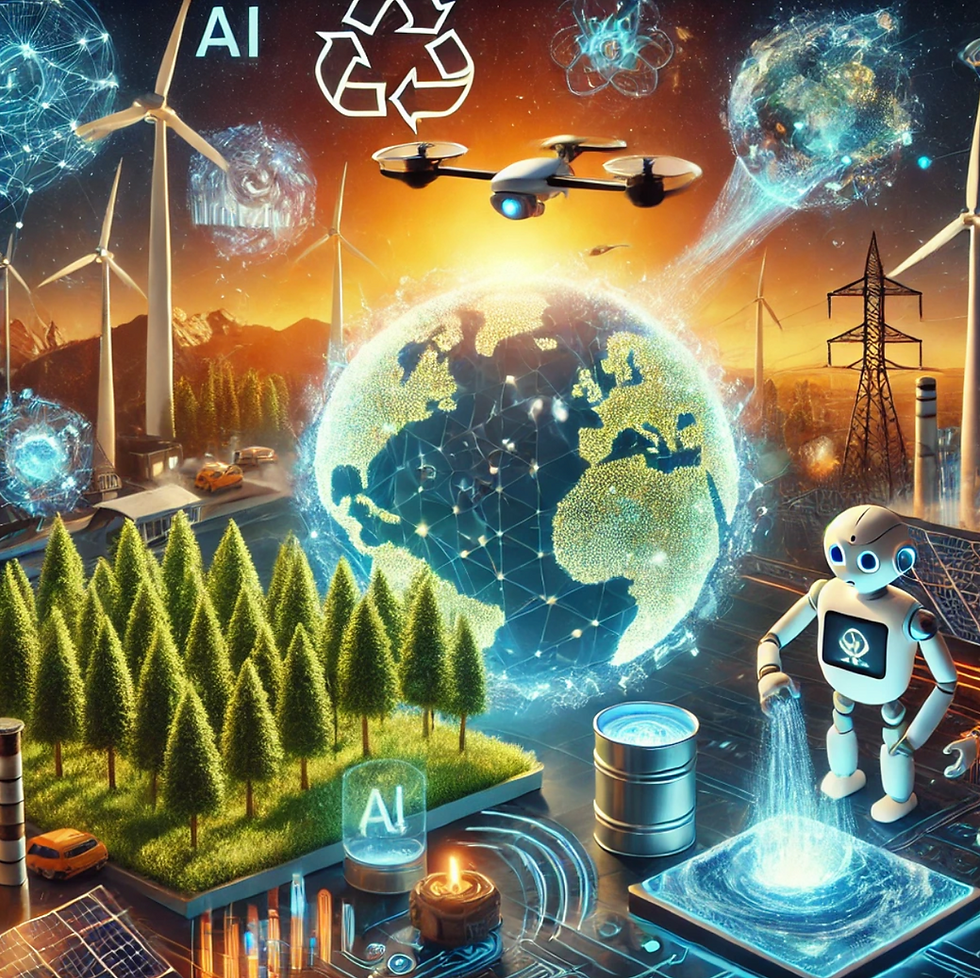AI Solutions: How AI Solves Global Challenges
- innovatewithstem12
- Mar 10
- 3 min read
by Sayohn J
published 10th March 2025
Artificial Intelligence has revolutionized various sectors, ranging from healthcare to transportation, but one of its most promising applications of AI lies in its potential to address global environmental challenges. As climate change accelerates, ecosystems become more fragile, and natural resources continue to deplete, AI technologies are emerging as powerful tools in the fight to protect and preserve the planet. AI is making substantial contributions to environmental conservation, from improving energy efficiency and reducing waste to predicting environmental disasters and promoting sustainable agriculture. However, despite its promise, the widespread use of AI in environmental management raises concerns that must be formally confronted.
One primary way AI contributes to environmental conservation is through improving energy efficiency. AI-driven systems can optimize energy use in buildings, manufacturing processes, and transportation, reducing carbon emissions and lowering energy consumption. For example, smart grids powered by AI can better balance energy demand and supply, ensuring that energy is used efficiently and that renewable sources, like wind and solar, are integrated into the grid effectively. According to a study by the International Energy Agency, AI technologies could help reduce global energy-related CO2 emissions by up to 4% by 2040 (IEA). This potential reduction is significant, considering that energy production and consumption are major contributors to climate change.
AI is also utilized in the prediction and management of natural disasters. By analyzing vast amounts of data from satellites, weather stations, and sensors, AI can forecast hurricanes, floods, wildfires, and droughts with greater accuracy compared to traditional methods. These predictions allow governments and organizations to take preventive measures and reduce the impact of disasters on human populations and ecosystems. For instance, AI has been used to predict wildfires in California with an 80% accuracy rate, allowing authorities to evacuate communities and deploy firefighting resources in advance (Linden, 2020).

In addition to energy management and disaster prediction, AI plays a crucial role in fostering sustainable agriculture. As the global population grows, the demand for food increases, putting pressure on land and water resources. AI technologies, such as machine learning algorithms and precision farming tools, help farmers optimize crop yields while minimizing resource usage. For example, AI-powered sensors can monitor soil conditions and weather patterns in real-time, which enables farmers to adjust irrigation schedules, fertilizer applications, and pest control practices more effectively. This reduces water consumption, minimizes the use of chemical fertilizers, and cuts down on the carbon footprint of farming. According to a report by the Food and Agriculture Organization, AI technologies have the potential to increase agricultural productivity by 60% while simultaneously reducing the environmental impact of farming practices (FAO, 2019).
While AI holds great promise in addressing environmental challenges, its implementation is not without potential risks. One of the key concerns is the environmental impact of AI itself. The computational power required to run AI algorithms, particularly deep learning models, is immense and requires significant energy resources. Training large AI models can result in carbon emissions equivalent to the lifetime emissions of several cars (Strubell et al., 2019). Moreover, the adoption of AI in environmental management must consider equity and access. While AI can offer solutions to global challenges, there is a risk that the benefits may be unevenly distributed. Developing countries, for example, may lack the infrastructure and resources to deploy AI technologies effectively. AI-driven solutions must be designed with inclusivity, ensuring that they benefit all regions and communities, particularly those most vulnerable to environmental threats.
In conclusion, AI has the potential to play a transformative role in addressing some of the most pressing environmental challenges of our time. Through advancements in energy management, disaster prediction, and sustainable agriculture, AI offers innovative solutions that can help mitigate the effects of climate change and protect natural resources. However, it is essential that the environmental impact of AI itself is carefully managed, and that its benefits are accessible to all. As AI continues to evolve, its role in global environmental conservation will likely become more critical, but its deployment must be handled with caution and foresight to ensure the future of our civilization.
Works Cited
Food and Agriculture Organization (FAO). The Future of Food and Agriculture: Trends and Challenges. FAO, 2019.
International Energy Agency (IEA). Artificial Intelligence and the Future of Energy. IEA, 2020.
Linden, Rob. "AI and Wildfire Prediction." California Tech Review, 2020.
Strubell, Emma, et al. "Energy and Policy Considerations for Deep Learning in NLP." Proceedings of the 57th Annual Meeting of the Association for Computational Linguistics, 2019.





Comentários